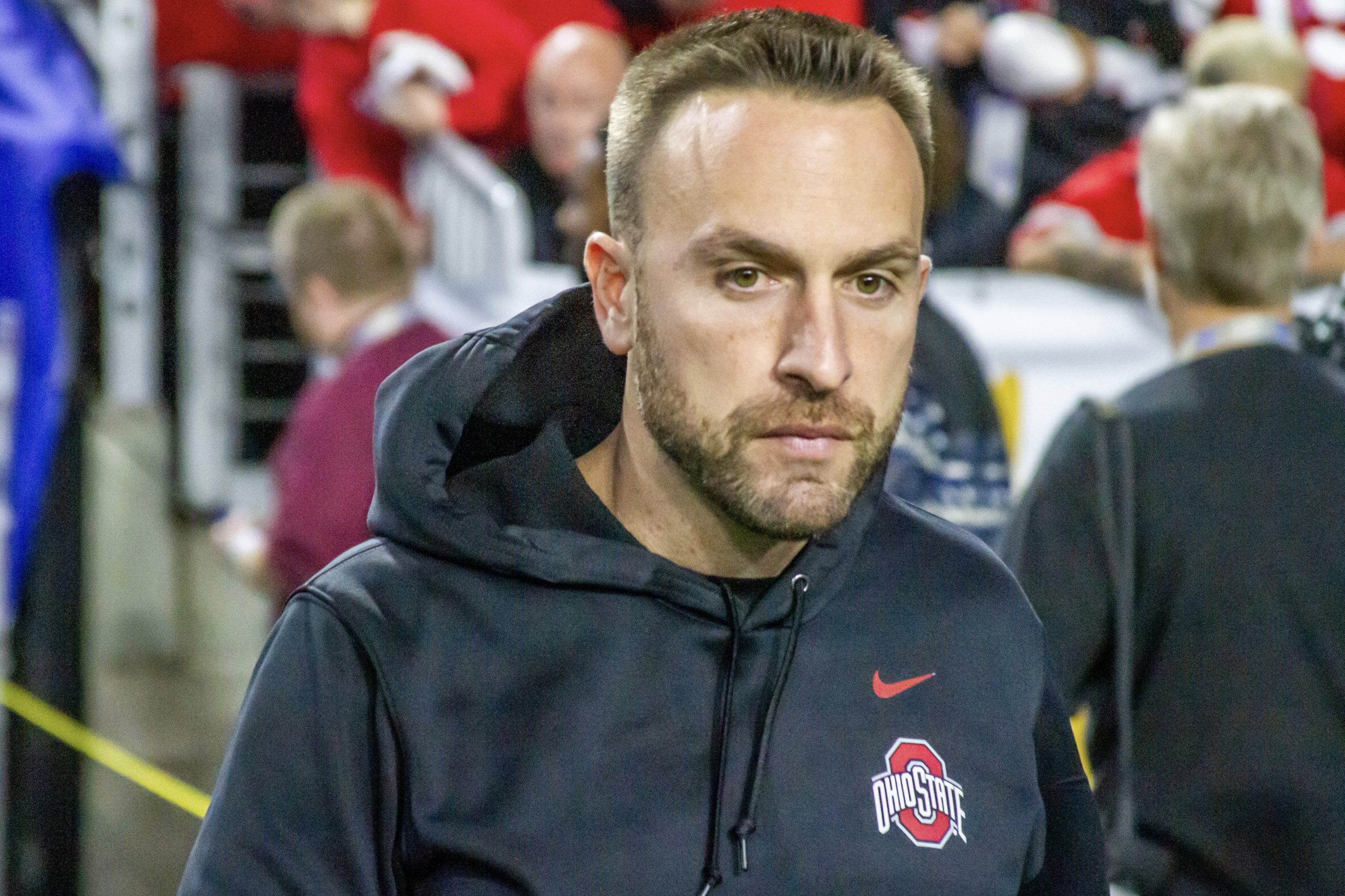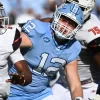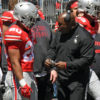
Ohio State had the right gameplan to beat Clemson, especially on the defensive side of the ball. The Buckeyes played a man coverage heavy game, used two high safeties to prevent big plays, and looked to get occasional pressure with delayed blitzes. The Buckeyes didn’t try to do too much in the running game, staying gap and assignment sound and forcing Clemson to grind for yardage.
It worked! It worked almost perfectly! Clemson struggled against Ohio State for much of the game, and as long as Ohio State was executing, the Tigers really had no answer. They were largely unwilling to chew up yards on long drives, and, when forced to play Ohio State’s game, couldn’t do it. Unfortunately for Ohio State, playing a full 60 minutes of perfectly executed football against Clemson is nearly impossible. It was a brutally physical game, and Ohio State simply got tired, regardless of referees or injuries.
On the few plays where Ohio State didn’t fully show up, or where there was a slight blown assignment, Clemson blew the doors off. That’s what elite football looks like, and it was a really tough reintroduction to elite football for Ohio State. Competing at the level that it did means that Ohio State is back among college football’s best, and should expect to be a playoff stalwart under Ryan Day. Losing in the way that it did means that Ohio State has to optimize the roster even more than it already has. More depth. Fewer weaknesses. Clemson is a football machine, and it was just a play or two better than Ohio State. That gap can be made up.
In the Fiesta Bowl, it couldn’t. That happens in big time college football, and while Ohio State isn’t about to celebrate a moral National Championship berth, there’s plenty to take from this game that should inspire hope for Buckeye fans that this wasn’t a one-off, and that this program is for real.
Unfortunately for Ohio State, and fortunately for the film study, there’s also plenty to harp on and to fix for the offseason.
As mentioned, this really was the perfect gameplan for Ohio State, especially early in the game. Clemson came out looking to test Ohio State’s defensive backs with big passes, while getting Trevor Lawrence involved in the running game to check on those linebackers. There were yards to be had, and a big pass on the second play of the game came on man coverage, but those yards were always going to happen. Ohio State was happen to bend but not break against Clemson, and it didn’t break until very late in the first half.
Take this play on the first drive as an example. Justyn Ross is open, by design. Damon Arnette is selling out to stop a big play, just as Jeff Okudah is on the other side, and he does just that. Lawrence makes the easy throw underneath, and Arnette gets down field quickly to make the play he needs to make, wrapping up and making sure that the short game Clemson settles for is all that this play ends with. Ohio State was daring Clemson to grind, and Clemson never really wanted to, even as it took the lead later in the game.
The same could be said on this Travis Etienne run. Ohio State isn’t doing anything flashy, with Pete Werner dropping into that second high safety spot as he has done this year to give the idea of a six man box, rather than the true seven man box that it actually is. Once the play actually starts, Ohio State just plays gap sound football. Shaun Wade plays the motion man, Werner and Malik Harrison take on the playside where Clemson is pulling a tackle and a guard, and Tuf Borland does an excellent job of trusting his assignment, staying right where he needs to be to hold Lawrence in check until he actually sees the handoff.
This one is another great example of that. Pete Werner and Baron Browning stay right in the gaps they need to be in, and Harrison trusts them enough to get outside and make sure that Lawrence will be stopped quickly if he decided to keep. Etienne is able to get a few yards, but the big play threat is neutralized with smart, disciplined defense. North Carolina was the only team that played Clemson like this all season long, and it very nearly resulted in an upset.
Could Clemson get four or five yards on a run like this ? Sure! Without a loaded box, that’s always going to be a concern. However, when the linebackers trust their assignments like this, there’s never going to be a big play.
When the assignments were missed, however…
It’s hard to say what exactly Josh Proctor is doing here (this will be a theme), but he certainly isn’t doing his job. He seems to bite too much on the action underneath, leaving Diondre Overton wide open behind him. Generally, as a safety, receivers being completely wide open 10 yards behind where you’ve decided to stand is not encouraged.
Outside of that, Ohio State was generally rock solid in the first quarter, because the defenders were still fresh. This was always going to be a physical game, and Ohio State had not yet taken the beating it was preparing to take, which makes it a lot easier to stay with assignments.
It also makes it a lot easier to run blitzes correctly, which Ohio State did ferociously and flawlessly early on.
Here, Ohio State attacks with a delayed blitz, which is essentially the first page of the handbook for stopping Clemson. It doesn’t get home, but Lawrence feels the pressure and doesn’t have the chance to look for something past the sticks.
Later in the quarter, Ohio State breaks it out again on third and short, and again makes life difficult for Lawrence.
This even carried into the second quarter. Obviously, this play will be remembered for the targeting call that ended Shaun Wade’s season, but from a schematic standpoint, this was brilliant. Ohio State runs a modified creeper blitz, dropping the tackle (Tyreke Smith) into coverage and bringing the simulated pressure on the edge from Wade, attacking Jackson Carman. Ohio State only needed four defenders to bring pressure, meaning that the rest of the defense can focus on coverage. Lawrence never had a chance here.
Now, this is where it’s time to break from the general thought a little bit. Had there been no penalty here, the drive ends, obviously. It was third down, and Ohio State was going to get off the field with its backfield fully intact. This was a massively impactful penalty, that without a doubt changed the game.
However, the cracks were showing before this. Clemson didn’t just magically appear past midfield, and the drive that had led to this point was not impressive from the Buckeyes. Ohio State started missing tackles, getting to gaps just a little bit slower, and trusting its eyes over its rules. The defense was getting tired regardless of a penalty, this play just serves as a tidy explanation, but one that doesn’t in any way tell the story.
The touchdown on this drive really shows it. Poor angles, missed tackles, and a touchdown that should have been a loss on third down. These Buckeyes are tired from a full half of bending against one of the nation’s best offenses. That’s a massive task, and it takes a serious toll on a defense.
As soon as Clemson paired that fatigue with the correct adjustment to what Ohio State was doing in the blitz game and against the run, it was over, regardless of what the scoreboard said.
That adjustment: the quarterback draw. It feels almost cosmically cruel that Ohio State’s death against Clemson came against the same exact play that led to that zero on the scoreboard next to Ohio State’s name back in 2016, but it makes sense, given what the Buckeye defense was doing. With the linebackers playing really well at staying disciplined, using Lawrence as a runner was a great way to both break that discipline and gain a numbers advantage. This massive touchdown run was the biggest of the bunch, but Lawrence gashed Ohio State on this exact play all game.
It wasn’t until the final drive that Ohio State actually covered it correctly, and, well, that didn’t go great for the Buckeyes either (more on that shortly). Here, the linebackers over pursue after reading halfback screen, and Baron Browning shuffles his way out of the gap Lawrence runs straight into. A missed tackle in the secondary, and just like that, a big play that Ohio State couldn’t afford. That’s all it takes. A gap mistake and a missed tackle. The defense was just gassed.
Halftime didn’t fix it, though the mistakes weren’t as frequent in the final 30 minutes as they were at the end of the first half. They were still there, however, and it was enough for Clemson to take advantage. On this Lyn-J Dixon carry, Clemson finally got Ohio State with that counter run look. Pete Werner commits far too much inside, and Ohio State is shifted too far over to account for the trips to make up for Werner’s mistake. There’s no one to set the edge on the weakside, despite Clemson using the weakside counter runs all season long.
A play later, and Clemson has the lead, because of poor angles and missed tackles. Ohio State was tired, and it got lazy just a few times. That’s the story of the game. Not penalties, or injuries, but Clemson’s depth being stronger than Ohio State’s when the depth needed to kick in. Ohio State needed to be the more physical team for 60 minutes to win, and it just wasn’t able to do it.
While the final drive for Clemson that sealed the game was primarily a continuation of Ohio State’s exhaustion, it is still worth breaking down.
The linebackers bite too hard inside again, and Lawrence again gashes them on a draw. Malik Harrison had a good game, but getting caught inside of the center on that play is egregiously bad, and it cost the Buckeyes dearly.
The next play was actually one of the few bad calls of the game from Jeff Hafley and Greg Mattison. Ohio State goes cover 3 with Prcotor looking to float back to protect the intermediate third, and Clemson has the answer for it, as it has all season. Ohio State didn’t let these kind of plays happen all game, but in crunch time, against an obviously passing team, this is a bad call. Clemson is designed to beat cover 3, and Ohio State knew that coming in. If you’re playing with fire, you’ll eventually get burnt.
The last play for the defense may have been its worst, because the linebackers actually covered what they thought they were seeing correctly. Browning didn’t get caught out of position, Harrison played the edge, and Josh Proctor stayed in, all in preparation for that quarterback draw that killed them all game. Clemson just made a great call, and Ohio State got caught assuming instead of following assignments.
These zones have to be further back, and the linebackers decided that it was more important to stop the draw than worry about the halfback. Clemson knew it was coming, and stuck the dagger in. With everyone else in man coverage, no help across the middle on the running back is never going to work, especially if that running back is Etienne. Ohio State adjusted to the draw, it just did it too late, and you can’t be late against Clemson.
That’s the story of the game. Ohio State was excellent, nearly flawless, and entered with a well-thought out gameplan. Clemson was Clemson. The margin for error is razor thin, and Ohio State made one too many mistakes. The Buckeyes can take more information from this game than any other this season, because this was a perfect representation of what it takes to win a national title in college football. If Day didn’t know before, he does now. If Ohio State wasn’t ready for the big time before, it is now. It just has to wait another year for another chance.









Great analysis! I believe that this game will solidify the beginning of Ryan Day’s Dynasty at Ohio State… Recruiting will only get better (and that seems impossible to do when Ohio State is in the top 5 every year as it is!), and we will wonder how Woody Hayes’, Jim Tressel’s and Urban Meyer’s teams actually look weak in comparison!
Fine analysis indeed. I just want to add that none of this would have mattered if Wade was not called for targeting. It was a horrible call and it did alter fate. Ohio State wins by double digits without that crap being called. The scoop and score on the fumble in the 2nd half would have been icing on the cake and that too was a horrible call. No one will ever convince me that was not a fumble.
We need to stop whining. We had three red zone opportunities. We gave up a 94 yard drive in 78 seconds. Our receiver changed his route. We let a relatively slow QB run 67 yards for a score. Defense was gassed after the third quarter. That’s why we lost.
Wade was textbook targeting. He was leading with the crown of his helmet. Watch any other game, and they all get flagged, especially when it’s on the QB. The rule sucks for sure. I do wonder if we get a tiered targeting system in the near future because of hits like this. The ‘fumble’ on the the other hand…
Very good analysis and your explanation was easy to understand. However, you imply that the blown calls by the officials had NO impact on the game. Surely a TD by the Bucks and a key defensive player being in the game to hold their score down had something to do with the outcome.
Yes, we’ll get better and hopefully the officiating does too!
GO BUCKS!
Bob Woods
That really is excellent commentary. So often in sports we focus on the Xs & os and forget about the humans. That bit of fatigue – that 1 step short – that loss of focus can be the difference between a successful scheme and failure. my experience with Buckeye enthusiasts has not been great these past few weeks but this was extraordinary – thanks.
Great analysis and video to support it.
Targeting is not allowed in college or in the NFL, and any time the tackler puts his head down when engaging in a tackle it will be called and the correct call is targeting. Should your guy been ejected from the game, I say know bc I don’t that it was intentional, but it was text book targeting, and the 15 yard penalty was the right call. On the incomplete pass, calls are made in regular speed of the game, and at normal speed, it clearly shown there wasn’t a FB move made to move the ball down field, and if the ball is put on the ground before the receiver makes a move to advance the ball, the correct call is incomplete. If that very same play had been with an OSU receiver, everybody in OSU nation would have agreed that it was an incomplete pass, 4th down, punt the ball… I know that is the truth, and so do you, but it is a hard pill to swallow bc it neglected a TD that you wish you had that would have helped you to win the game, but it would have been a good win if the ref would have clearly made the wrong call, and all of OSU nation would have known that to be a fact. And if the call would have been on the other side, it could have caused you to lose bc the ref made a bad call and gave Clemson a TD on an incomplete pass bc your guy dropped the ball before he had possession and never made a FB play before he dropped the ball or got it knocked out of his hands!!!!